Since I’ve published Tilly’s Very Bad Day I figure I should update my painting guide for the Thirty Years War (1618-1648). This is the guide for the Swedes. It is applicable for Swedes throughout the war but of course it is most relevant to the Swedish Phase (1630-1635) and after.

General notes on the Swedes
Based on plates in Brzezinski (1991, 1993) troops in Swedish service wore:
| Item | Colour |
|---|---|
| Hats (if worn) | grey or tan:
|
| Hair (their own) | Various |
| Tunic, cloaks, cape | uniform colour. Recruits were issued grey. Individual men would wear whatever they could get hold of to replace worn out cloths | Breeches | in a colour to match the coat, or grey or brown. Breaches were tied at the knee by a ribbon in a matching or contrasting colour |
| Shirt (hence collar), stockings, officers lace | White |
| Leather (Boots + straps + belt, gaiters etc) | could be black or brown, but items were typically:
|
| Sash, scarves | Pretty much white until May 1632 then red. |
| Plate armour and helmets | Blackening and burnishing were used to prevent rusting. |
| Buffcoat | Buff (often worn over plate armour) |
| Staves for standards | Natural |
| Officer sash | blue from 1645; before that any colour except imperialist red although I guess blue gradually predominated |
The example is a unit of recruits, admittedly well equipped. Recruits were issued grey uniforms. They have a bit too much armour and the armour is too bright. But you get the idea. Notice the blue sashes on the two officers. Although a “grey” unit, some men have replaced items of clothing (breaches) with non-regulation colours.


Swedish Armour
The Swedes were armour poor. Plate armour was rare and the Swedes were forever trying to find more. Even a buffcoat, either sleeveless or with sleeves, was expensive so only some officers in Swedish service could afford them (Brzezinski, 1991). When worn, sleeveless buffcoats were more common.
Swedish Officers
Up to 1630 Swedish officers seemed fond of black (Brzezinski, 1993). I guess afterwards anything goes.
Swedish officers wore sashes of a variety of colours, but in 1632-35 they avoided the Imperialist red (Brzezinski, 1993). By 1645, i.e. very late in the war, blue sashes became more standard.
Swedish Cavalry
Although Gustavus intended the cavalry have uniforms, there is little evidence that cavalry in Swedish service actually wore them (Brzezinski, 1993). In fact during this period cavalrymen usually wore whatever they liked. Few had buffcoats, with most men wearing a cloth coat.
The Swedes found it difficult to obtain armour and by 1632 there is little evidence of cavalry using armour (Brzezinski, 1993). The shortages meant that in late 1630 Gustav had ordered only the front rank of his mercenary regiments be issued armour. The native Swedish regiments may have been better equipped.
Swedish cavalry wore sashes of a variety of colours, but in 1632-35 they avoided the Imperialist red (Brzezinski, 1993). By 1645, i.e. very late in the war, blue sashes became more standard.

Broadly speaking there were three types of cavalry in the Thirty Years War (Brzezinski, 1993). The type affected how the men behaved, or more importantly for a painting guide, how they looked.
- Arquebusier (Harquebusier, Bandelier Reuter, Carbine): men armed with an arquebus. The better equipped would have a back and breast and/or a helmet.
- Horsemen (Reiters, Lätta ryttare): men armed with pistols. They might have back and breast and a helmet, or a hat and no armour at all. For example, native Swedish cavalry.
- Cuirassier (Kürisser, Kürassirer, corazzen): men in 3/4 armour and helmet, armed with pistols. Over time their equipment lightened and they essentially morphed into Horsemen.
The native Swedes were the second type, horsemen. The Swedish heavies were never as fully armoured as their European counterparts. They started the war with just a back and breast or just a buff coat. Later in the war the Swedish cavalry wore no armour.
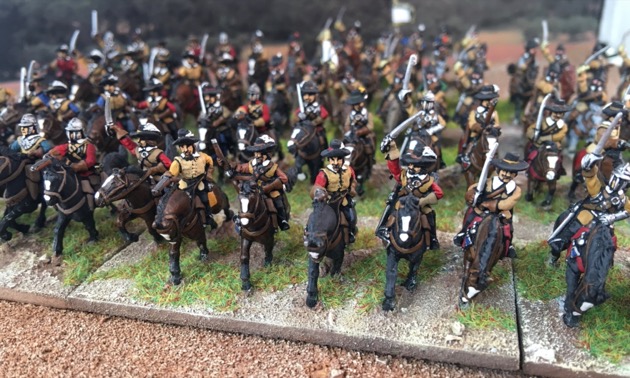

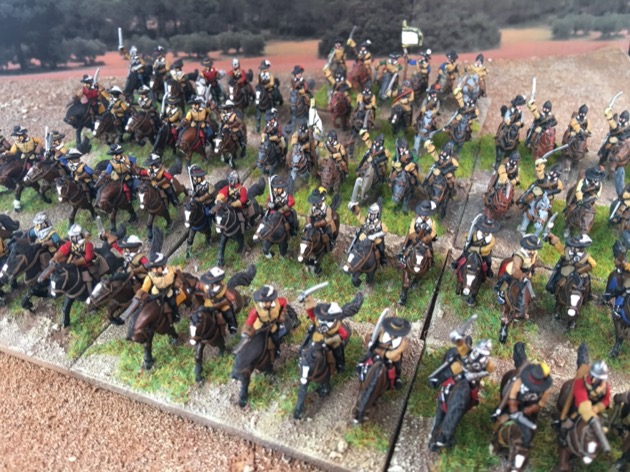
The Swedes had access to German harquebusiers who would have looked much like the Swedes:
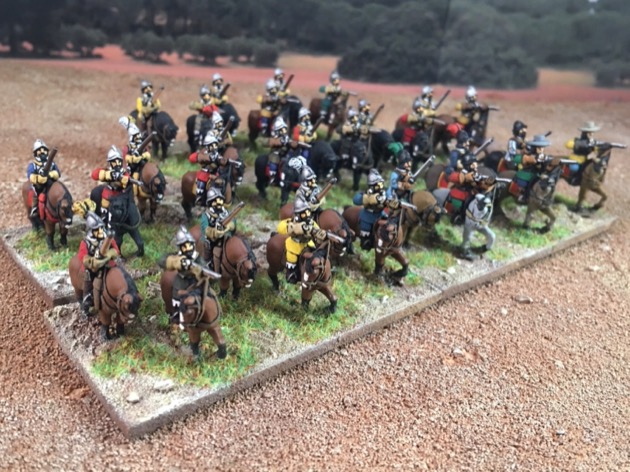
Swedish Infantry
Until about 1620 Swedish conscripts – infantry by definition – were issued woollen clothes of a natural greyish-white (Brzezinski, 1991). From 1620 regimental trim was added to the greyish-white.
From 1626 infantry regiments began to issue coats of a uniform colour – both Swedish and mercenary (Brzezinski, 1991). Some of the coloured regiments (at least Yellow, Blue/Old Blue, Red) adopted coats of a matching colour, and others may have done the same. Some non-coloured regiments also adopted uniform colours. Bear in mind, however, that references to “any-colour-at-hand cloth” are common, reflecting the fact that suppliers were not shy of providing a mixture of colours to a regiment if they couldn’t provide a single colour.

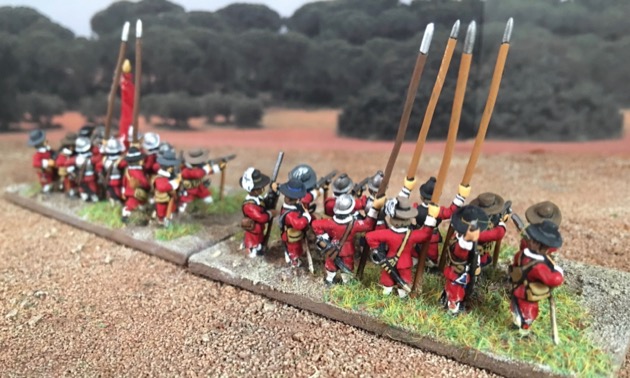
There is some evidence that Gustav was trying to standardise on blue uniforms for native Swedish troops (Brzezinski, 1991). Examples of native Swedes wearing blue are the “New Blue Swedish regiment” recorded in 1628, the two Swedish brigades at Breitenfeld, and the Swedish brigade at Lutzen.


There is some evidence that Scottish units at least partially wore undyed grey cloth, which could be either for coat or breeches (Brzezinski, 1991). Both Scots and Irish favoured blue bonnets, and might have worn checked trews until these were replaced by other cloth. My Scottish unit has blue bonnets and a grey uniform.

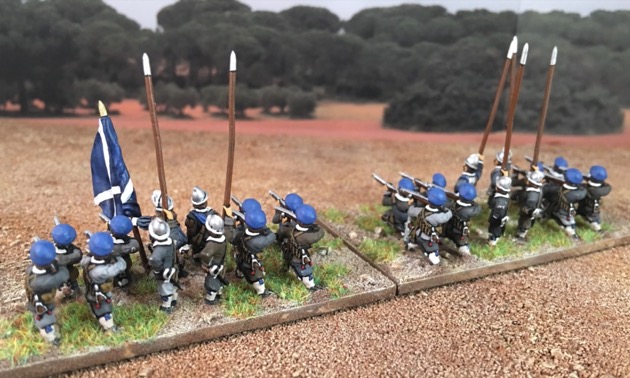
Swedish pikemen were meant to wear back and breast, gorget, tassets for thighs, and a helmet (Brzezinski, 1991). The musketeers were meant to wear a helmet. By 1635 the Swedes no longer tried to give their infantry armour as the men threw it away anyway.
During 1624-28 some Swedish musketeers were issued swinesfeathers in addition to their musket rests (Brzezinski, 1991).
After Gustav died the supply of clothing deteriorated and the Swedish armies of the late 1630s were ragamuffin in appearance (Brzezinski, 1991).
Swedish Coloured Infantry Regiments
Swedish colour names were usually about the flag not the uniform. Only a few Swedish regiments with colour name had a uniform that matched regiments colour name (Brzezinski, 1991):
- 1625-27 the first Swedish coloured regiments acquired their names, although the units already existed:
- Yellow. Raised 1624 and named “Yellow” from 1626, and had a yellow coat.
- Blue. Raised 1624; renamed “Old Blue” from 1634; had a blue coat.
- Red. Raised 1624-25; had a red coat.
- Green (raised 1627; unclear if had a green coat but some units were clothed in green).
- 1628 “New Blue Swedish Regiment” (as distinct from the “Old Blue” mercenary unit).
- 1629-30 the Swedes raised new coloured regiments: Three Black (1629), a fourth Black (1630), Orange (1630), Brown (1630), White (1630)


For simplicity, even if it is not strictly historical, all my Swedish infantry units have uniforms and uniform colours that match the flags. I’ve got Yellow, Blue, Red, Green, Scottish and Grey.
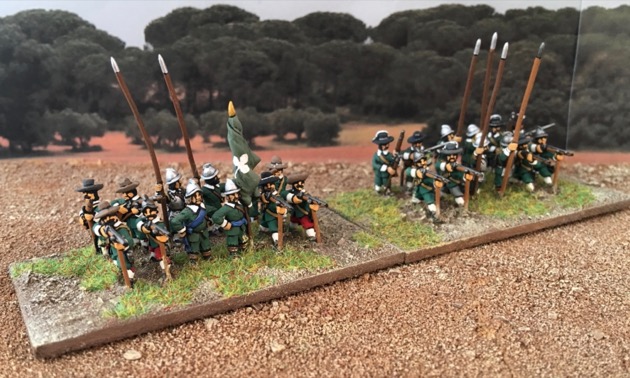
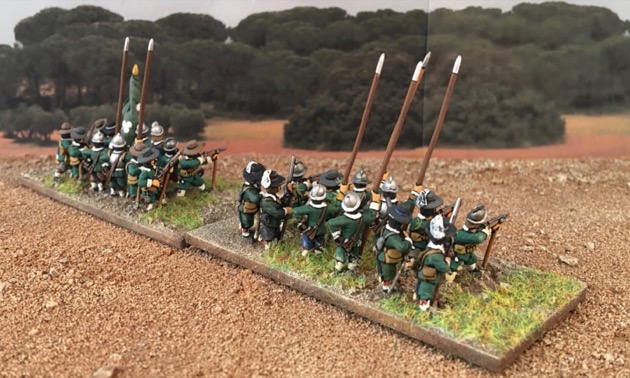
Swedish Dragoons
Dragoons in Swedish service were issued cloth, and being considered infantry may have been given uniforms. The only documented example is black cloth issued after Gustav’s death (Brzezinski, 1991). In 1633 one company of the Yellow Regiment was reclassified as dragoons and probably kept their yellow uniforms.
Swedish Artillery
Most artillerymen were native Swedish, although man power was bulked out with commanded musketeers (Brzezinski, 1991, 1993). The professional artillerymen probably wore black, or other dark colours.
Swedish Flags
http://www.angelfire.com/ak5/alexflags/swedish.html has very good wargaming flags. Further comments by Daniel S on the Slitherine FOGR forum:
The red, blue and yellow Swedish flags are to a large extent based on the Möhner paintings. However the maker has made his personal interpretation of the designs rather than copying the originals. (The fleur de lys, crowns and moon on the blue flags are diffrent for example). The use of the 3 crowns in the yellow flags is conjectural. The flag with a cross of St. Andrew, crown and ‘GARS’ is a nice piece of research since it come from the flags described by Hoppe who saw such flags in Elbing in Prussia 1626-29. These flags are of course those of the Yellow, Blue and Red regiments. The green flags are those of Thomas Sigmund von Schlammersdorf’s regiment while the top 3 blue flags are conjectural designs, good ones expet for the one with a ordinary cross. (Which the Swedes didn’t use on land).
Swedish Fieldsigns
Swedish fieldsigns varied over time (Brzezinski, 1993):
- At Breitenfield (17 Sep 1631) green branches in hat or helmet, and possibly green sashes.
- From late 1630s: twisted bands of straw in hat and/or on left arm.
- At Wittstock (4 Oct 1636) small green sashes around their arms
Where to get Tilly’s Very Bad Day
Tilly’s Very Bad Day is available for Download (PDF).
Acknowledgements
Roland Davis painted the vast bulk of my Thirty Years War armies including the vast majority of the Swedish figures.
Ebay provide some of the horsemen in the back of the pictures.
My only contribution is to put them all on Big Bases.
References
Brzezinski, R. (1991). The Army of Gustavus Adolphus (1): Infantry [MAA 235]. Osprey.
Brzezinski, R. (1993). The Army of Gustavus Adolphus (2): Cavalry [MAA 262]. Osprey.
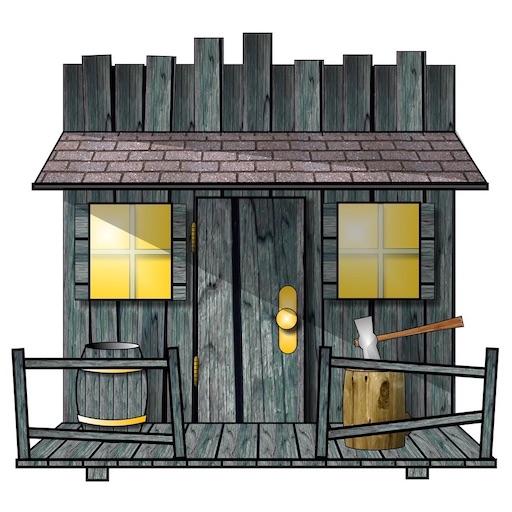

I wish I had this 10 years ago. I did a late Swedish army and pretty much went with coloured uniforms, German style, for the infantry but with a mixture of figures and quite a few non standard items.
My cavalry had far too much armour, but I was aware that that was incorrect, but it was partly because my Imperialist cavalry from the earlier period were quite heavily armoured, and all the rules we tried gave quite an advantage to armoured cavalry.
It’s worth mentioning that Harbarqubusiers went out of favour as they had a reputation for firing one shot and then disappearing to reload and never returning. In Swedish service they seem to have been replaced by dragoons who were trained for mounted action.
I keep collecting armies before the appropriate figures, wargaming resources and painting guides are available. I’m not sure I’ll ever change. The periods that interest me will continue to interest me regardless of what other wargamers are doing.
The majority of my Thirty Years War cavalry are interchangeable between armies. They are split into Arquebusier, Horsemen and Cuirassiers. Swedish cavalry were Horsemen throughout. German cavalry, including those in Swedish service and otherwise, started with a combination of Arquebusier and Cuirassiers, then transition to Horsemen during the Swedish phase.
You’re right Harbarqubusiers had a bad reputation, but there are instances of all of these types of horse shooting when they should charge. That is why Gustavus made the charge doctrine.
“Mounted action” is a bit ambiguous. I believe dragoons in the Thirty Years War rode to battle and fought dismounted, regardless of the nation. That is why, for example, the Swedes could form a dragoon unit from the Yellow foot regiment. They only thing that changes was they got issued a nag. Proper charging dragoons came much later – 18th century – when governments realised they could pay less for cavalrymen if they called them a dragoon. And that is why British cavalry regiments all became dragoons or hussars. 🙂
So when did this magical transformation of all British cavalry into Dragoons or Hussars take place ?
1700 the British regular establishment included nine horse regiments and eight dragoon regiments (who fought dismounted)
1746 George II reduced the three senior horse regiments to the status of dragoons in order to save money (Dragoon Guards were paid less than Horse)
1759 British cavalry defined as either light cavalry (Light Dragoon regiments) or the heavy cavalry (Dragoon and Dragoon Guard regiments). Henceforth, all newly raised regiments of cavalry would be denoted Light Dragoons
1788 the remaining four Horse regiments were retitled as the 4th through 7th Dragoon Guards.
From …
https://en.wikipedia.org/wiki/Cavalry_regiments_of_the_British_Army
https://www.rdgmuseum.org.uk/history-and-research/former-titles-of-the-regiment/